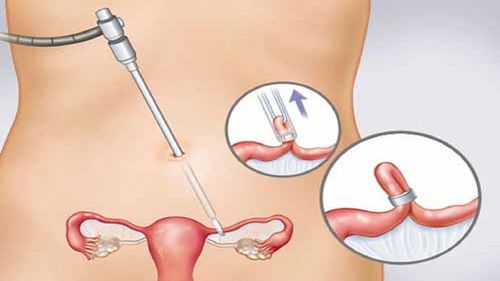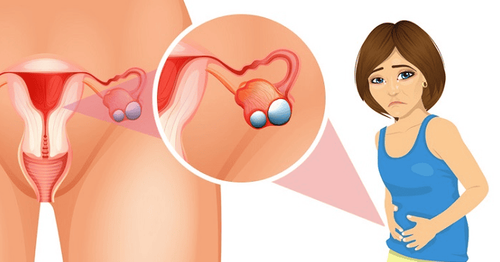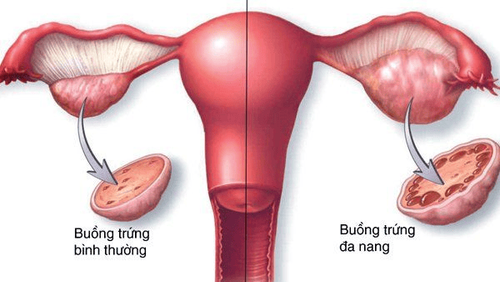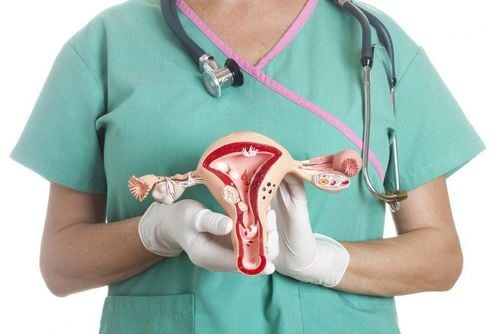This is an automatically translated article.
The article was professionally consulted with Specialist Doctor II Tran Thi Mai Huong - Obstetrician and Gynecologist - Department of Obstetrics and Gynecology - Vinmec Hai Phong International General Hospital.Ovarian cyst is a fairly common gynecological disease, which is benign in nature. However, in some cases, the tumor grows rapidly, which can lead to dangerous complications if not promptly intervened.
1. Benign ovarian cyst
An ovarian cyst is a fluid-filled sac located in the ovary or on the surface of the ovary. This is a fairly common gynecological disease. Many women are found to have ovarian cysts at any stage of their life, from being a pre-pubescent girl to becoming an old woman.Most ovarian cysts are benign because they are follicles that do not degenerate after an egg has been released. In the majority of cases, cysts are asymptomatic and are sometimes discovered accidentally. After a few menstrual cycles, ovarian cysts go away on their own without any treatment.
However, ovarian cysts - especially in patients with ovarian cysts that rupture - can cause serious symptoms. Accordingly, to protect their health, every woman should have regular pelvic exams and exams, knowing the symptoms could signal a serious underlying problem.
2. Symptoms of benign ovarian cysts
Most ovarian cysts are functional cysts, they cause no symptoms and go away on their own. However, a large ovarian cyst can cause the following:Pelvic pain - a dull or sharp pain in the lower abdomen on the side of the cyst Distention or heaviness in the abdomen Bloating If there are complications If a cyst ruptures or an ovarian torsion, the patient will suddenly experience severe abdominal pain, vaginal bleeding, nausea and vomiting, pale skin, rapid breathing, and a drop in blood pressure. These are gynecological emergency symptoms and need to take the patient to the hospital immediately.

3. What are the causes of ovarian cysts?
Most ovarian cysts develop as a result of each menstrual cycle. These are functional cysts. Other types of cysts are much less common.3.1. Functional cyst The ovary is a female reproductive organ whose function is to nourish eggs and release eggs each month. The egg is protected and provided with nutrients by the follicle. The follicles produce the hormones estrogen and progesterone, which release an egg when it's time to ovulate, helping to regulate the menstrual cycle.
If a normal monthly follicle continues to grow even without an egg, it is called a functional cyst. There are two types of functional cysts:
Benign ovarian cysts: In the middle of the menstrual cycle, an egg will break out of the follicle and enter the fallopian tube, reaching the uterine cavity for a chance to be fertilized. sperm, nest. At this point, the remaining follicle will dissolve on its own, starting the cycle of a new follicle. Thus, an ovarian cyst will form when the follicle has not ruptured or has released an egg but continues to grow. Luteal ovarian cyst: When the released egg is fertilized and formed an embryo, the follicle will not disappear, but will continue to produce estrogen and progesterone to maintain the endometrium, creating favorable conditions for the embryo. nesting fetus. Ovarian follicles are now called corpus luteum cysts. When the placenta is formed and continues to maintain hormone levels in the blood, usually between 10 and 12 weeks of pregnancy, the corpus luteum will gradually degenerate. If for some reason the corpus luteum is still growing, producing fluid into an empty sac and increasing in size, it is called a corpus luteum cyst. 3.2. Other types of cysts Other types of cysts that may contain fluid, solid or mixed substance and are of a nature unrelated to the normal function of the menstrual cycle, include:
Germ cell tumors: Also known as cysts heck. The tumor can contain a variety of tissues, such as hair, skin, or teeth, because they form from embryonic germ cells. Germ cell tumors rarely transform into cancer. A glandular cyst: This type of cyst is usually located on the surface of the ovary and is filled with water or mucus. Endometrial cyst: The nature of the cyst is similar to that of endometrial cells, which are still affected by a true menstrual cycle but grow outside the uterus.
4. How to diagnose an ovarian cyst?
A cyst on an ovary can be found easily during pelvic exam and ultrasound examination. Depending on its size and nature, whether it's fluid or thick or mixed, your doctor may recommend additional tests to determine the type of ovarian cyst and whether treatment is needed. Tests may include:Pregnancy test: A positive pregnancy test may suggest a corpus luteum cyst. Pelvic ultrasound: Transvaginal ultrasound will clearly show images of the uterus and ovaries as well as the presence of a cyst, determining whether the contents are liquid, thick or mixed. Laparoscopy: A very small camera and light source are inserted into the abdomen through a very small incision. Thanks to that, the doctor can see the ovaries and at the same time intervene to remove the ovarian cyst. This is a surgery that requires anesthesia and is performed in an operating room with adequate resuscitation facilities. CA 125 blood test: Levels of a protein in the blood called cancer antigen 125 (CA 125) are often elevated in women with ovarian cancer. If the cyst is solid or solid in nature and increases your risk of ovarian cancer, your doctor may order this test. However, elevated CA 125 levels can also occur in the absence of cancer, such as endometriosis, uterine fibroids, and pelvic inflammatory disease.
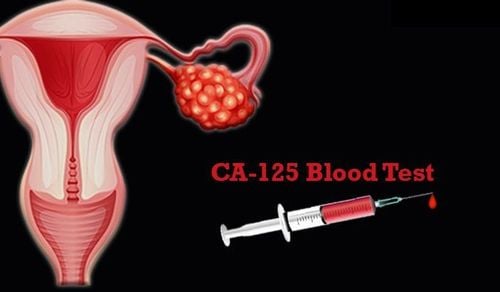
5. Treatment of Ovarian Cysts
The treatment regimen for ovarian cysts is dependent on the age, type, nature and size of the cyst as well as the symptoms it causes. Accordingly, the doctor will give one of three directions as follows:Watchful waiting: In many cases, the patient can wait and be checked with repeat ultrasound to see if the cyst disappears within a few days. few months no. This is usually an optimal choice, regardless of age, if there are no symptoms at all and an ultrasound shows only a simple, small, fluid-filled cyst. Medication: Your doctor may prescribe hormonal medications, such as birth control pills, to keep ovarian cysts from coming back. However, birth control pills will not be able to shrink an existing cyst. Surgery: If an ovarian cyst is large, doesn't look like a functional cyst, is growing again over two or three menstrual cycles or is causing pain, surgery is indicated, especially if it causes problems. complications of ovarian cysts. If the removed cyst is cancerous, the patient will need to see an adjunct oncologist. Occasionally, a complete removal of the uterus, ovaries, and fallopian tubes may be necessary, along with adjuvant chemotherapy or radiation therapy to prevent metastases. In short, ovarian cysts are all benign and inherently not too scary because most are benign, cause no symptoms and sometimes will go away on their own after a few menstrual cycles. However, it is necessary to have the above knowledge, to recognize the warning signs when ovarian cysts cause complications or become malignant in order to intervene in timely treatment and protect their own reproductive health.
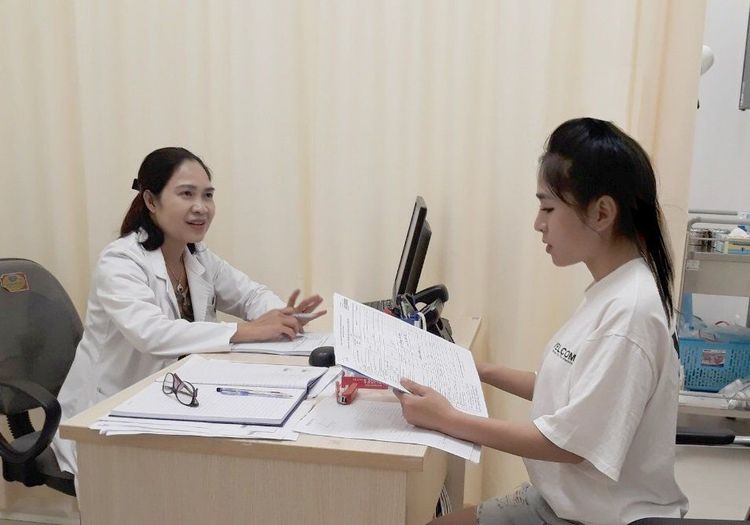
Female customers have several factors Risks such as poor personal hygiene, unsafe sex, abortion, ... Female customers have other symptoms such as: abnormal vaginal discharge, itching, pain in the intimate area, vaginal bleeding abnormal. Irregular bleeding in the vaginal area Menstrual problems: irregular periods, irregular periods Abnormal vaginal discharge (smell, different color) Pain, itching in the vagina. If you have unusual symptoms, you should be examined and consulted with a specialist.
Please dial HOTLINE for more information or register for an appointment HERE. Download MyVinmec app to make appointments faster and to manage your bookings easily.





